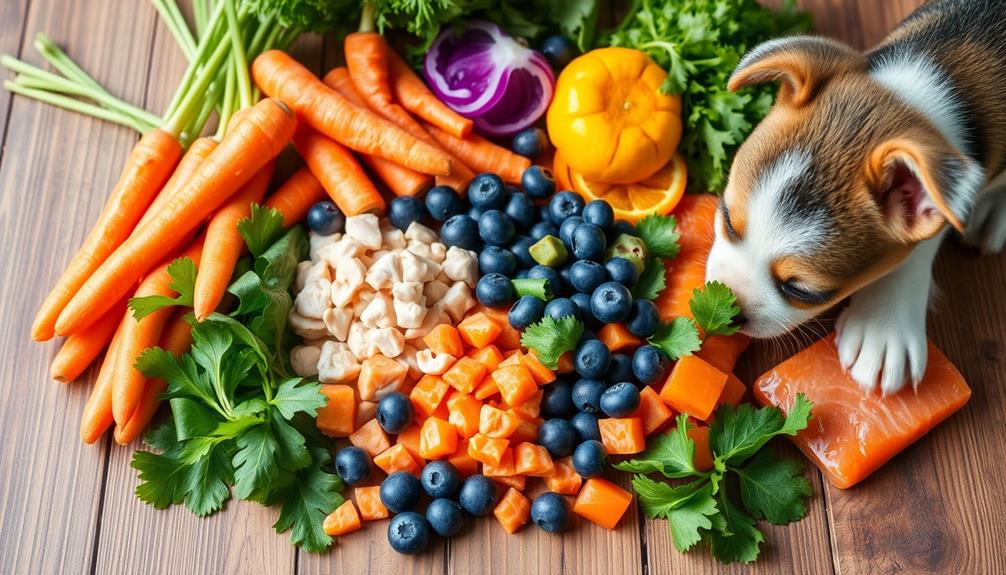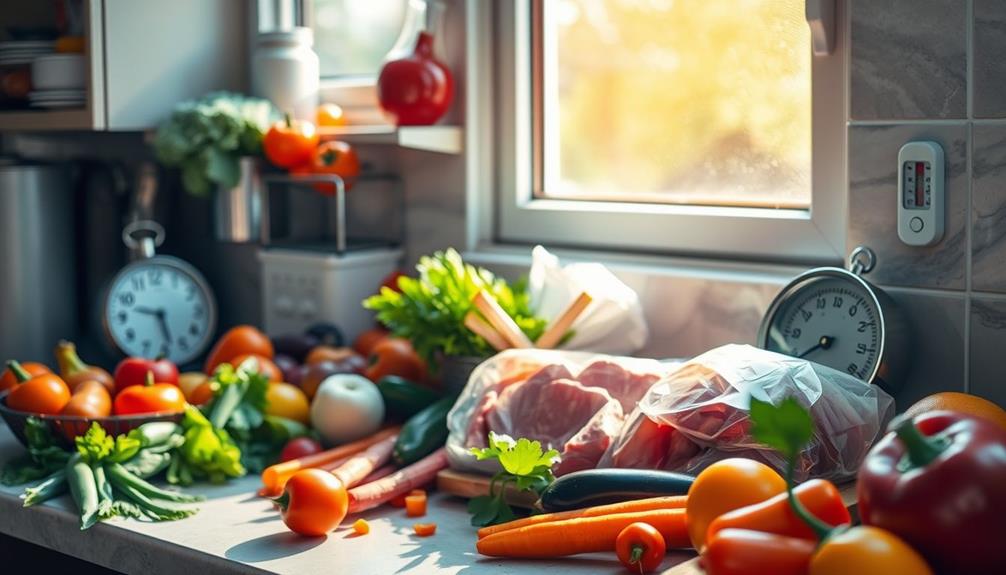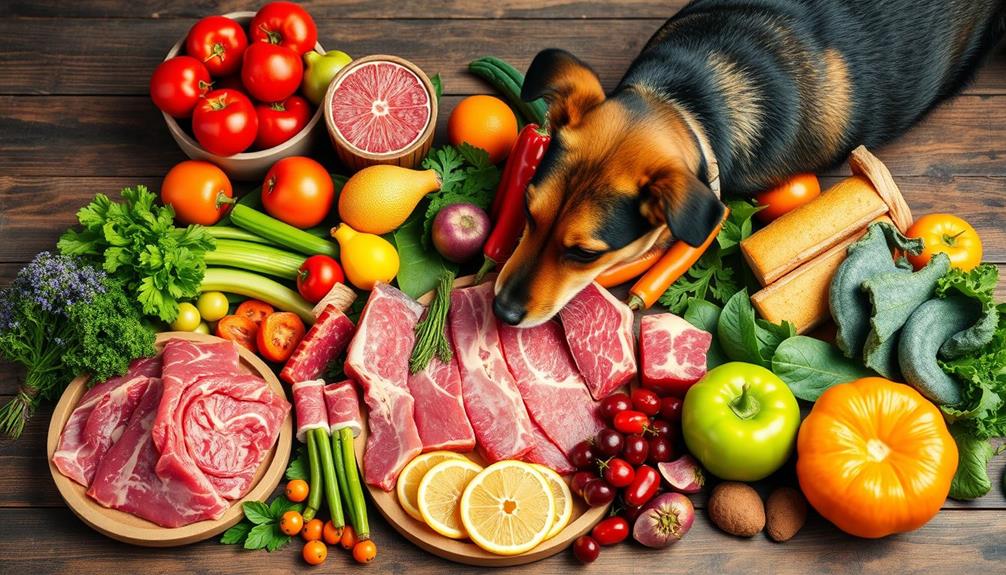You can give puppies a raw food diet that includes high-quality proteins like muscle and organ meats, along with raw meaty bones. Safe options include beef, chicken, and turkey, which provide essential nutrients. Introduce fruits and vegetables like carrots and blueberries in moderation for variety. It's crucial to shift gradually to avoid digestive upsets. Puppies generally need about 4%-10% of their body weight in food daily. Keep an eye on their reactions to guarantee a balanced diet. Discovering more about the specifics can help you make informed choices for your puppy's health and happiness.
Key Takeaways
- Raw puppy food should primarily consist of high-quality proteins like muscle meat, organ meats, and raw meaty bones for balanced nutrition.
- Safe raw foods include beef, chicken, turkey, and organ meats like liver, while fruits and vegetables can be added in moderation.
- Avoid harmful ingredients such as grains, fillers, and cooked bones that can splinter and pose choking hazards.
- Transition to a raw diet gradually, starting with a mix of 20% raw food to minimize digestive upset.
- Monitor puppies' digestive reactions and adjust portion sizes based on their growth and activity levels for optimal health.
Understanding Raw Puppy Food
When it comes to feeding your puppy, understanding raw puppy food is essential for their growth and well-being. This diet should primarily consist of high-quality proteins like muscle meat, organ meats, and raw meaty bones. These ingredients are critical for supporting your puppy's rapid growth and development.
Achieving nutritional balance in their diet is important; you need to guarantee it includes essential vitamins and minerals, particularly calcium and phosphorus for strong bone health. Additionally, incorporating safe snacks for puppies, similar to safe snacks for hamsters, can provide variety and enhance their overall diet.
Puppies have higher calorie needs than adult dogs, requiring about 4%-10% of their body weight in food daily, depending on their age and activity level. To enhance their diet, you can include fresh fruits and vegetables in moderation, but be cautious to avoid harmful foods like onions and grapes.
When moving your puppy to a raw diet, a gradual approach is essential. Start by mixing raw puppy food with their current diet to minimize digestive upset. This careful change helps your puppy adjust while guaranteeing they get the nutrients they need for a healthy start in life.
Nutritional Needs of Puppies
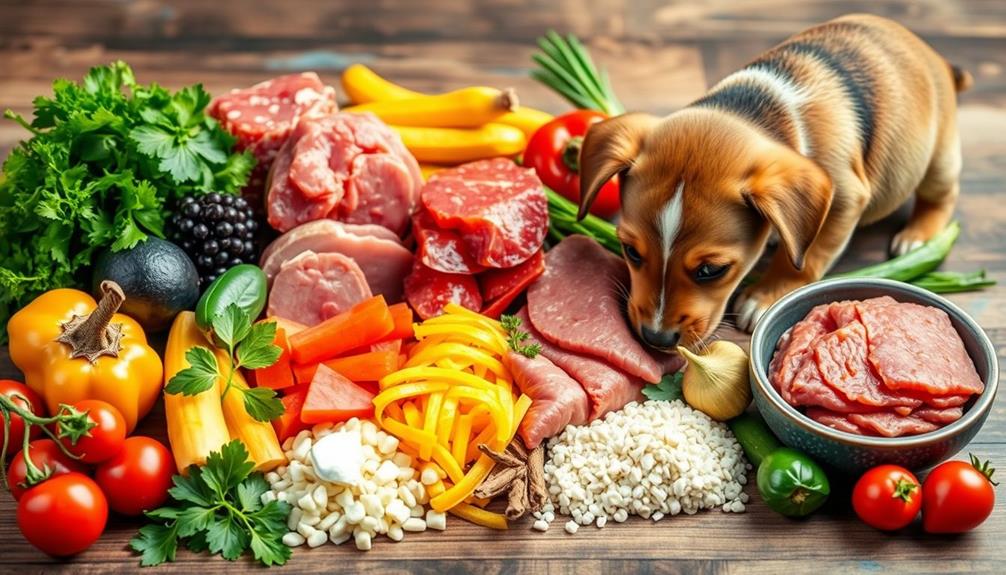
Puppies have unique nutritional needs that are imperative for their rapid growth and development. Unlike adult dogs, they require a diet higher in calories and protein, typically needing 4%-10% of their body weight daily, depending on age and activity level.
A balanced raw diet is essential, incorporating a variety of muscle meats, organ meats, and raw bones to guarantee they receive important nutrients. It's also important to evaluate the role of hydration, as fresh food contributes to their overall water intake and helps with digestion, which is similar to how cold medications can provide effective relief during illness.
Protein plays a significant role in muscle development, while calcium is necessary for strong bones. Additionally, a balanced ratio of fats and carbohydrates supports their overall health. Fresh, easily digestible foods are particularly important for puppies, as they help prevent gastrointestinal issues and enhance nutrient absorption during these developmental stages.
You should focus on wholesome animal parts, guaranteeing the food is nutrient-dense and avoids harmful ingredients. This approach not only meets their nutritional needs but also minimizes the risk of allergens specific to individual puppies.
Safe Raw Foods for Puppies

Ensuring your puppy's diet includes safe raw foods is vital for their health and development. When considering what puppies eat raw, focus on raw muscle meat like beef, chicken, and turkey. These proteins provide a variety of sources, contributing to balanced nutrition. Additionally, including organ meats such as liver and kidney in their diet provides essential vitamins and minerals that are crucial for their growth. It’s important to also incorporate raw bones into their diet as they serve as a natural source of calcium and other nutrients. Overall, providing a balanced and varied raw food for puppies is key to ensuring their long-term health and well-being.
Incorporate raw meaty bones, such as chicken necks and wings, which are important for calcium and help maintain dental health through natural chewing. Additionally, providing healthy dog snacks can enhance their overall well-being and keep them satisfied.
Don't overlook organ meats, especially liver, as they're nutrient-dense and should comprise about 5% of your puppy's raw diet for ideal vitamin intake.
As for fruits and vegetables, options like carrots and blueberries can be included in moderation. To boost digestibility and nutrient absorption, consider pureeing or lightly steaming them.
It's essential to avoid harmful ingredients like grains and fillers, as well as certain bones—especially cooked bones—that can splinter and pose choking hazards.
Transitioning to Raw Diet

Adjusting your puppy to a raw diet requires a gradual approach, starting with a mix of 20% raw food and 80% of their current diet.
It's important to track their nutrient intake and guarantee a balanced diet, as proper nutrition is essential for growth and development.
As you modify the proportions daily, keep a close eye on their digestive reactions and be ready to tweak the portion sizes if needed.
Maintaining a consistent feeding schedule will help your puppy adapt smoothly to their new meals.
Additionally, understanding the importance of budgeting for pet expenses can help you manage the costs associated with a raw diet.
Gradual Transition Process
When introducing a raw diet to your puppy, it is essential to take a gradual approach to prevent digestive upset. Start with a 25% raw food mix combined with 75% of their current diet for the first three days. After this initial phase, increase to a 50/50 mix for another three days, then move to a 75% raw and 25% old diet for three more days. Ideally, you should achieve a complete raw diet by Day 10.
During this shift, it's imperative to monitor your puppy's body weight and body condition score to guarantee they receive the appropriate amount of nutrition. The recommended daily raw food intake for puppies generally falls between 4%-10% of their body weight, depending on their age and growth stage.
Here's a simple overview of the gradual shift process:
| Day Range | Raw Food Mix | Old Food Mix |
|---|---|---|
| 1-3 | 25% | 75% |
| 4-6 | 50% | 50% |
| 7-9 | 75% | 25% |
| 10+ | 100% | 0% |
This structured approach helps your puppy's digestive system adjust smoothly to feeding a raw diet.
Monitoring Digestive Reactions
As you move to a raw diet for your puppy, it's important to keep a close eye on their digestive reactions. During the shift, watch for signs of diarrhea, vomiting, or changes in stool consistency; these can indicate dietary intolerance or adjustment issues.
Be aware that financial considerations for elder care can also impact your ability to provide the best nutrition for your pet. A gradual shift over 7 to 10 days is key, starting with 20% raw food and 80% of their current diet. Increase the raw percentage while monitoring their response.
Puppies might experience mild digestive upset during this period, but symptoms should resolve within a week. If issues persist, consider adjusting the type or amount of raw food you're introducing.
Regularly weighing your puppy and monitoring their body condition score can help guarantee they're adjusting well to the new diet and receiving proper nutrition.
If significant digestive issues arise, don't hesitate to consult with a veterinarian or pet nutritionist. They can provide tailored advice based on your puppy's specific needs and health status, guiding you through the shift while guaranteeing your puppy's health remains a top priority.
Adjusting Portion Sizes
Adjusting portion sizes is essential for your puppy's health during the change to a raw diet. Start by providing about 10% of their body weight in food daily for younger puppies, like those around 8 weeks old. As they grow, you'll want to gradually decrease this to about 4% by the time they reach 6 months, depending on their activity level.
It's important to remember that just like in human development, environmental interactions, such as diet, can greatly influence a puppy's growth and health key factors in development.
To guarantee your puppy maintains a healthy weight, consider these tips:
- Monitor their body condition score regularly.
- Adjust food portions based on their growth and activity.
- Use online calculators to determine precise feeding amounts.
Puppies need more frequent meals, especially those between 8 to 16 weeks, usually requiring 4 meals a day. By 16 weeks, you can shift to 3 meals daily.
Always stay vigilant and adjust portion sizes as necessary. Overfeeding can lead to unwanted weight gain, while underfeeding can stunt growth. Keeping a close eye on your puppy's body weight and meal frequency will help you make informed adjustments, ensuring they thrive on their new raw diet.
Preparing Raw Meals

Preparing raw meals for your puppy requires careful attention to balance and nutrition. To guarantee proper nutrition, you should aim for a balanced ratio of 70% muscle meat, 10% raw bone, 5% liver, 5% organs, and 10% fruits and vegetables. Incorporating essential oils for health can also enhance your puppy's overall well-being.
Start by gradually introducing raw food over seven days, beginning with 20% raw mix and increasing to 100% to avoid digestive issues.
When preparing raw meals, always weigh the portions to target a daily intake of 2-5% of your puppy's body weight. Adjust this based on their growth and activity levels. Incorporating whole cuts of meat promotes dental health, but you must also maintain strict hygiene protocols. This means cleaning surfaces and tools thoroughly to avoid contamination.
Using high-quality ingredients is vital, so opt for USDA-certified meats whenever possible. Properly store raw food to keep it safe and fresh.
Supplements for Puppy Diets
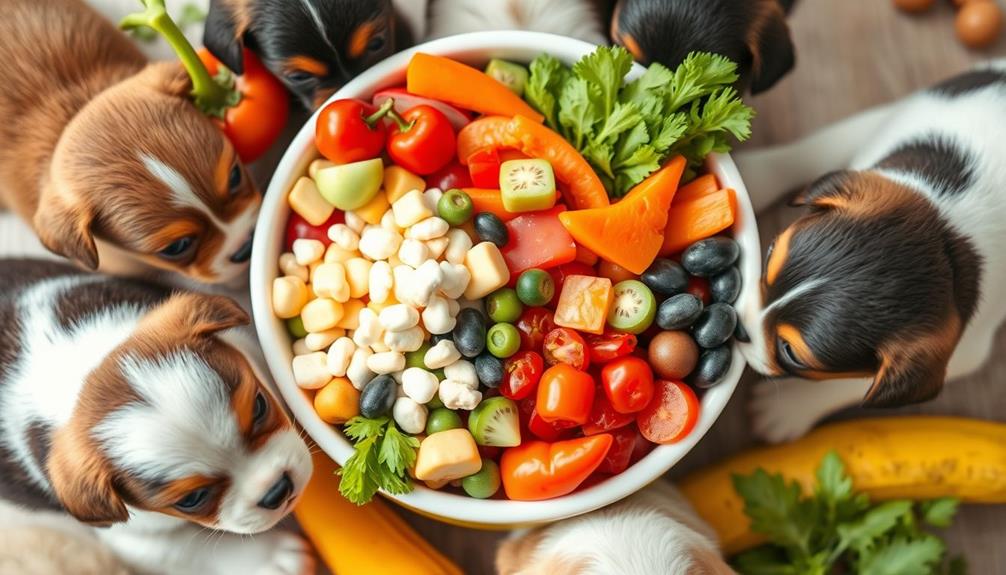
Puppies thrive on balanced diets, but sometimes their nutritional needs require additional support from supplements. Incorporating specific supplements can greatly enhance your puppy's overall health and development. For instance, beetroot characteristics suggest that incorporating natural sources of antioxidants may also support their immune system.
Here are some essential ones to take into account:
- Omega-3 fatty acids: Fish oil is a fantastic source that promotes healthy skin, coat quality, and cognitive function.
- Calcium and phosphorus: These are important for proper bone development. Maintaining an ideal calcium-to-phosphorus ratio of approximately 1.4:1 is essential.
- Probiotics: These help establish a healthy gut microbiome, especially for puppies moving to a raw food diet.
Additionally, vitamin E can reduce inflammation and support your puppy's immune function, enhancing their overall health.
Zinc supplements may be necessary to prevent deficiencies often seen in raw diets, promoting skin health and immune function.
By including these supplements in your puppy's diet, you'll help guarantee they receive the balanced nutrition they need for healthy growth and development.
Always consult your veterinarian before adding supplements to your puppy's diet to tailor the best approach for their unique needs.
Potential Risks of Raw Feeding
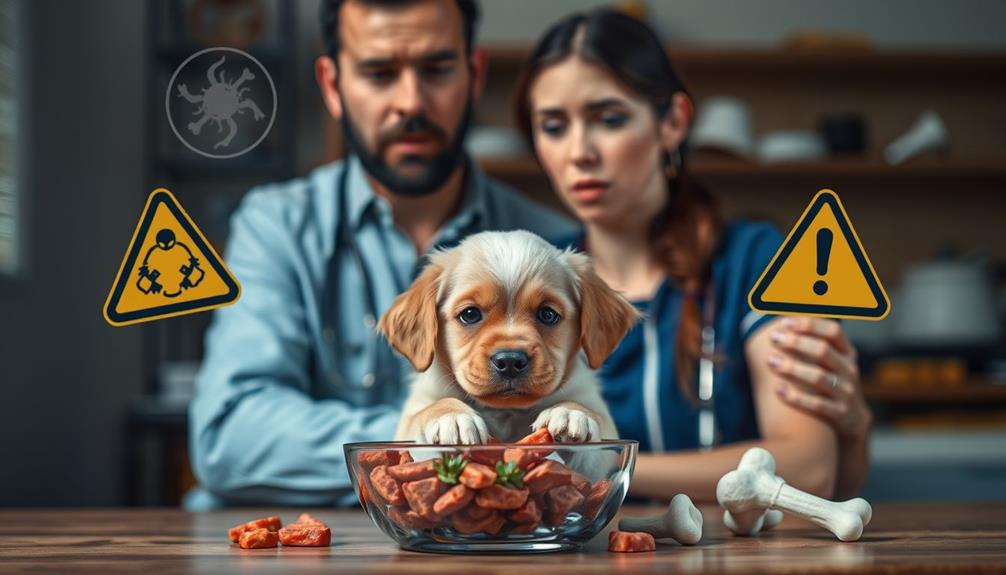
When considering raw feeding for your puppy, you need to be aware of potential nutritional imbalances and pathogen contamination.
Many homemade raw diets lack essential nutrients, and individuals with specific disorders, such as Borderline Personality Disorder (BPD), may also experience heightened emotional responses that could influence their decision-making regarding pet care.
Additionally, raw meats can carry harmful bacteria like Salmonella and E. coli.
It's vital to weigh these risks against the benefits before making a decision.
Nutritional Imbalances Risks
Feeding raw diets to puppies can lead to serious nutritional imbalances, posing risks that every pet owner should be aware of. A balanced raw diet is essential for your puppy's growth and development, much like selecting the best heat pump is necessary for maintaining ideal home comfort.
Without proper formulation, homemade raw diets often lack important vitamins and minerals like vitamin E, zinc, and iodine.
Consider the following risks:
- Inadequate calcium and phosphorus levels, which are crucial for healthy bone development, can occur if the calcium:phosphorus ratio isn't maintained.
- Solely feeding muscle meat without including organ meats can lead to nutritional deficiencies, as organ meats provide necessary nutrients.
- Puppies may develop nutritional osteodystrophy, a condition linked to imbalanced diets, resulting in skeletal developmental issues.
To make sure your puppy thrives, always aim for a balanced raw diet that incorporates a mix of muscle, organ meats, and bones.
Regularly consult with a veterinarian or a pet nutritionist to guide you in formulating a diet that meets your puppy's specific nutritional needs.
Pathogen Contamination Concerns
In recent years, the popularity of raw diets for pets has sparked concerns about pathogen contamination. Studies reveal that raw pet food can harbor harmful pathogens like Salmonella and E. coli, with 20% of commercial raw diets testing positive for Salmonella and a staggering 64% for E. coli.
The FDA warns of these health risks, highlighting the significance of proper handling and hygiene practices to protect both you and your puppy.
Bacterial load studies show that raw diets generally have higher levels of contamination compared to dry or canned foods, with nearly 50% of raw samples containing E. coli. This raises significant concerns, especially since there are zoonotic diseases associated with raw feeding. By feeding your puppy raw meat, you could increase the chances of transmitting pathogens from your pet to yourself, particularly with Salmonella.
While freezing meat can help reduce the risk of parasites, it doesn't eliminate it entirely. The FDA recommends specific freezing temperatures and durations to effectively kill parasites.
It's essential to stay informed about these risks if you choose to feed your puppy a raw diet.
Veterinary Guidance on Raw Diets
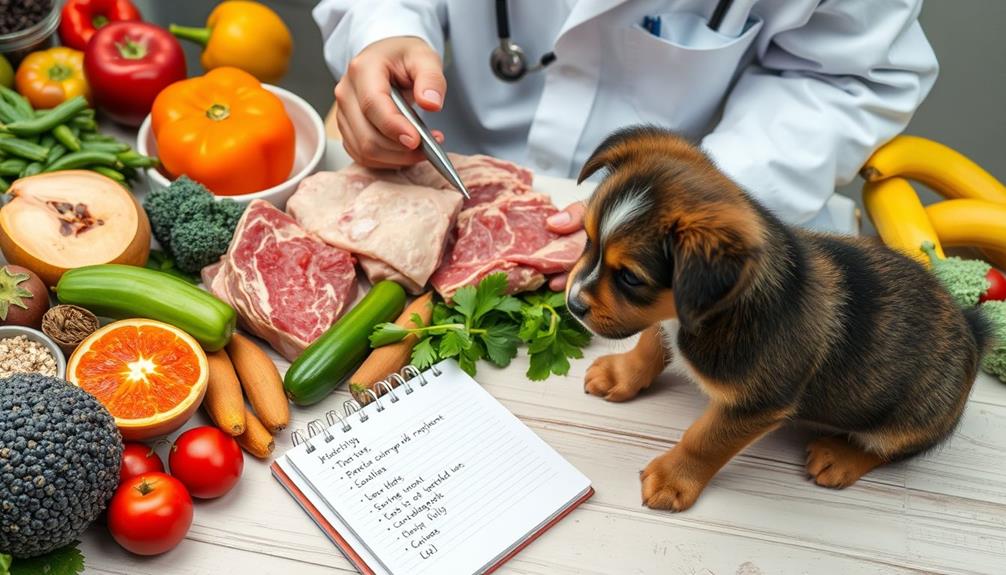
Veterinary guidance on raw diets for puppies is essential for pet owners considering this feeding approach. Major veterinary associations, like the American Veterinary Medical Association, highlight significant concerns about the safety and nutritional adequacy of raw diets. Consulting with a qualified professional is imperative before making the change, as many homemade formulations can be improperly balanced, leading to nutritional deficiencies.
Consider these key points:
- Raw diets may not meet your puppy's unique nutritional needs.
- Pathogens like Salmonella and E. coli can contaminate raw food, posing health risks.
- Education on food safety and handling practices is essential for all pet owners.
Veterinarians emphasize that without proper vet guidance, moving to raw feeding can result in serious health issues, such as nutritional osteodystrophy in growing puppies.
Ensuring your puppy receives a balanced diet is paramount, as any shortcomings can affect their development.
By working closely with a vet, you can navigate the potential risks and make informed decisions that support your puppy's health and well-being.
Always prioritize professional advice to safeguard your furry friend's future.
Frequently Asked Questions
What Raw Food Is Safe for Puppies?
When considering what raw food's safe for puppies, focus on raw muscle meats like chicken and beef, include raw meaty bones, and add small amounts of organ meats, fruits, and veggies for balanced nutrition.
What Are the Guidelines for Raw Feeding Puppies?
Did you know puppies need 4-10% of their body weight in food daily? To raw feed, start with four meals daily, shift gradually, and guarantee a mix of muscle meat, bone, and organs for balanced nutrition.
At What Age Can You Start a Puppy on a Raw Diet?
You can start your puppy on a raw diet around eight weeks old. Gradually introduce it mixed with their current food, ensuring it's calorie-appropriate and rich in protein to support their growth and energy needs.
Do Vets Recommend Raw Food for Puppies?
Most vets don't recommend raw food for puppies due to nutritional imbalances and bacterial risks. It's essential you consult a veterinarian or pet nutritionist to guarantee your puppy gets a balanced diet for healthy growth.
Conclusion
In summary, embracing a raw food diet for your puppy can be a rewarding journey, akin to planting seeds for a healthy future. By understanding their nutritional needs and carefully selecting safe foods, you can nourish your furry friend with vigor and joy. Remember, shifting slowly and seeking veterinary guidance are key to success. With the right approach, you'll watch your puppy thrive, bursting with energy and happiness, like a garden in full bloom.

